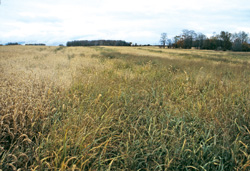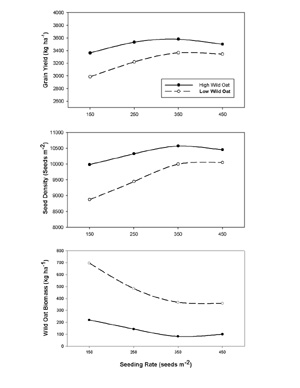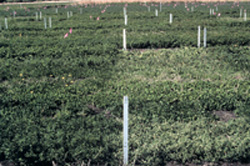
Features
Agronomy
Seeding/Planting
Minor Use registration program a hit
Minor Use Pesticide Program (MUPP) brings new registrations to special crop growers.
November 28, 2007 By Bruce Barker
Established in May of 2002, the Minor Use Pesticide Program (MUPP) is now paying
dividends to Canadian growers. To-date, 39 Minor Use registrations have been
obtained across Canada, on crops as varied as chicory to coriander. And with
registrations such as Attain and Prestige in forage grass for seed and Puma
Super in perennial ryegrass for seed, the Minor Use Pesticide Program has just
started to bear fruit.
 |
| Grass herbicide tolerance trials helped to screen for new pesticide uses. Photo Courtesy Of AAFC, Scott, Saskatchewan. |
"I think it is really a success story in the pesticide regulatory industry,"
says Eric Johnson, a research scientist at Agriculture and Agri-Food Canada
(AAFC) at Scott, Saskatchewan, who along with Dan Ulrich of AAFC Scott have
invested a significant amount of time in screening for, and working on, Minor
Use registrations.
The Minor Use Pesticide Program was established as part of the Agricultural
Policy Framework, and was jointly established by AAFC and Health Canada. In
2003, AAFC and Health Canada's Pest Management Regulatory Agency (PMRA), together
with industry and the provinces, established the Pesticide Risk Reduction and
Minor Use Programs. The Minor Use Program is designed to improve access to minor
use pesticides. The Pesticide Risk Reduction Program complements the work being
done in the Minor Use Program, by focussing on priorities for pest management,
including biological controls and safer pesticides for minor as well as major
crops.
Ulrich says a 'minor use' pesticide refers to fungicides, insecticides and
herbicides used on low acreage crops, or where pest control is only needed on
a small portion of the overall crop acreage. These pesticides are usually used
in such small quantities that manufacturers find the sales potential is not
sufficient for them to seek registration in Canada. Crops grown in small areas
include vegetables, fruits, specialty crops, herbs and spices, as well as nursery
and landscape plants and flowers. These are often high value and are sometimes
called 'minor crops' because they are grown on significantly smaller areas of
land compared to the large acreages of crops like corn, soybeans, canola and
wheat.
 |
| 281 crop pesticide evaluations have been conducted at Scott under the Minor Use Pesticide Program. Photo Courtesy Of AAFC, Scott, Saskatchewan. |
Funding drives and streamlines registrations
In 2002, the Government of Canada committed $54.5 million for six years to develop
and implement the Minor Use Program. Within the Minor Use Program, AAFC is using
its share of $33.7 million to improve access to minor use pesticides and to
conduct field trials on minor use pesticides. PMRA is using the remaining amount
($20.8 million) to increase its capacity to review submissions, and to provide
shorter time lines for registration decisions on new reduced risk products.
Other key partners in the Minor Use Pesticide Program are provincial governments
and grower organizations.
Investing in competitiveness
Under the Minor Use Pesticide Program, AAFC works with provincial governments,
industry representatives and producers to match pest problems with minor use
pesticide solutions, establish priorities and gain industry support, conduct
field trials and prepare pesticide submissions for new uses to PMRA. In Alberta,
Dan Cole is provincial minor use co-ordinator with Alberta Agriculture, Food
and Rural Development (AAFRD) at Edmonton. One of his main tasks is to sort
out the minor use priorities.
"We're trying to focus on what pesticides growers need for a specific
crop, or what the new crops are that don't have the pesticides registered and
that are needed to successfully grow the crop," he says. "The Provincial
Minor Use Priority Setting Workshop provides a wonderful opportunity for growers
to participate in the process, to help get the tools they need to deal with
weeds, insects and diseases that are jeopardizing their crops."
Cole urges growers to work with their provincial co-ordinators to identify
and prioritize the pest problems in their region. These pest problems then are
matched with potential pesticide solutions using input from pesticide manufacturers
to produce provincial lists of pest priorities and possible solutions in three
categories: weed, disease and insect. Non-chemical solutions are also considered
and included.
Provincial lists are then combined to form one national list, which is used
at the annual AAFC Minor Use Pesticide Priority Setting Workshop, usually held
in March, to determine national priorities. Representatives from a broad range
of stakeholder groups including provincial minor use co-ordinators, producers,
the pesticide industry, crop specialists, as well as representatives from the
US Interregional Research Project No. 4 program, and provincial and federal
governments attend the workshop. American participation helps share pesticide
registration information cross-borders to help build stronger pest management
programs that are beneficial to both countries.
 |
| Mustard is a crop that few pesticide companies conduct screening trials on. Photo Courtesy Of AAFC, Scott, Saskatchewan |
Once the priorities are established nationally, AAFC's Pest Management Centre,
in consultation with industry and government partners, initiates the next steps.
They seek formal manufacturing support, prepare documents to determine any additional
data requirements, co-ordinate field trials and laboratory analyses, provide
quality assurance for the data-generation process, integrate data with the US
IR-4 program, prepare registration submissions to PMRA, and provide transparent
tracking and reporting to stakeholders.
Pre-screening an important component
Johnson says that in addition to the registration process for Minor Use, the
Pesticide Risk Reduction Program and the Saskatchewan Minor Use Program have
contributed funds to assist in the screening of potential pesticides that may
be suitable for registration. He explains that this is an important step in
the minor use process, since the funders do not want to 'waste' a federal priority
by trying to register a product that does not work, or which the crop does not
tolerate.
At Scott, most of the screening work has involved herbicides. Some of the earliest
screens involved wild oats herbicides for use in canaryseed. However, for the
most part it was unsuccessful, as canaryseed showed inadequate tolerance to
herbicides such as Puma Super or Everest.
A lot of the screening effort has focussed on sulfentrazone, a Group 14 herbicide
that is registered in the US. Sulfentrazone has a unique mode of action to western
Canada, therefore it could be an effective tool in managing herbicide resistant
weeds, such as Group 2 resistant kochia. It has potential for use in chickpeas,
sunflower, field peas, fababeans and flax. The effort put forward on the screening
trials has led the manufacturer, FMC, to sign an agreement with Nufarm to market
and distribute the herbicide in Canada once the product is registered. In addition,
carfentrazone, which has been screened as a tank-mix partner with glyphosate,
will be entering the Canadian market through the FMC-Nufarm agreement.
More recently, screening has begun to evaluate herbicides in oilseeds and industrial
hemp. Also, screening has begun on tame mustard through support from the Saskatchewan
Mustard Development Commission. It is hoped that this screening will result
in recommendations for minor use priorities to the Minor Use Pesticide Program
in the future.
 |
| Much of the Minor Use Pesticide Program work done by AAFRD has been on legumes. |
Moving ahead
In Alberta, the process has also produced positive results. Previously, Cole
was more involved with weed management in forage crops, resulting in several
Minor Use registrations, and now he is working on weed management in newer crops.
"I have appreciated the priority setting process and the helpfulness of
AAFC and PMRA in obtaining a couple of minor uses for pest management in lupin
and fababean, and knowing what other pesticides we have a chance of getting
registered on lupin and fababean," says Cole. "We now have a team
of people who have been conducting weed efficacy and crop tolerance trials on
lupin and fababean in central Alberta over the last threeyears. We have a fair
bit of data so that Rudy Esau, minor use procurement officer with the Prairie
Pesticide Minor Use Consortium (PPMUC), is now submitting four Minor Use Pesticide
Program applications, with several more to submit in the near future."
Cole explains that Esau's work is a contribution from the Alberta Pulse Growers
Commission, a consortium member. Cole says that the PPMUC is always looking
for grower group members who would like help with applying for and obtaining
Minor Use registrations. -30-
|
Minor Use success at AAFC, Scott |
|
|
Of 281 crop pesticide evaluations conducted at Scott under the Minor Use Pesticide Program, 211 were crop tolerance trials, 56 were pest efficacy (control) and 14 were pesticide residue. The Scott program provides an example of how important this program is to prairie growers. 39 different minor crops have been evaluated
|
47 different pesticide products or product combinations have been evaluated through the Minor Use Program at Scott since 2003…
149 minor use field trials have been conducted
Minor Use Program at Scott has collaborated
|